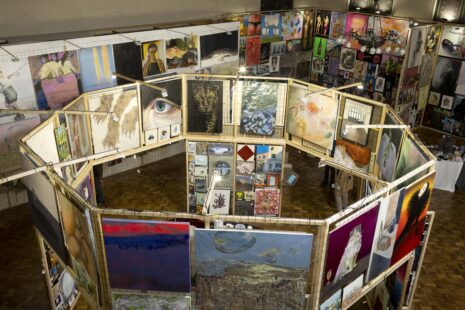The current edition has landed in the small fishing-town of Svolvær, in a four-storey beautiful abandoned building that used to house the local newspaper, Lofotposten. Being clearly affected by years of abandonment, the building is exceptionally expressive. Partly teared-down walls, teared-up floors, pipes and cables all over, mold and umber rust. Sometimes it is even competing with the artworks that it hosts, and the smaller and more tactile works seem to disappear in all the details.
Despite this, the building suits the festival perfectly – practically, aesthetically and symbolically. It gives the artworks all the space that they could wish for in addition to reflecting the town it inhabits. Because Svolvær is in large part characterized by decay and abandonment.
The festival’s ability to reflect the local and mix it with the global and the universal is its true strength, in my opinion.
A kitschy curiosity
The former Lofotpost building, The North Norwegian Art Centre (NNKS), the local cinema and an old second-hand shop are mentioned as venues for this years LIAF. But to be clearer about it, the biennale is mainly in the Lofotpost-building, a little bit at NNKS, and sporadically at the cinema and the shop. While the Lofotpost-building is full of impressions, NNKS has a single highlight: the huge pink universe of the Canadian artist Tricia Middleton.
It is a total installation consisting of everything from smells to sounds, images to found objects and sculptures. There are things in every corner of the room, hanging, leaning, laying. On pedestals and tables, from the roof and on the floor. With its pink, transparent textile and porcelain kittens, it looks cute, light and cheerful. But it has a creepy and dark undertone.
One of the first things I register is the damaged boat laying centrally on the floor. As reference to fishermen, trash in the oceans and decay, the installation immediately appears to have obvious relation to Lofoten. But combined with the porcelain cat-figures, speakers playing French songs and large images of antique ruins, it is more of a mystery.
Part of it is the kitsch. Tons of small nips: porcelain figures of kittens, doll shoes, birds, shells, roses, hearts and swans. My mind goes to the American artist Jeff Koons and his celebration of American middle class kitschy taste. But the underlying feeling of Middleton’s presentation has less of a celebratory undertone. It rather emphasizes the status of the nips as excess things, and as the figures are mixed with blades of grass, it rather appears as trash. I feel the tension between the beautiful façade of capitalism with its many things, and the repulsive feeling towards trash. Linking it to the boat and the ocean, it becomes something unwanted, out of place. It is a sickening experience as the glitter and gold are beautiful, but not in the grass and the oceans.
The “too much” is the point of the installation, but it is also its great struggle at times. Particularly the printed images of the antique ruins placed in a lonely corner, is a reference to “too much”, unsynchronized with the rest. Without this, it is already plenty to digest.
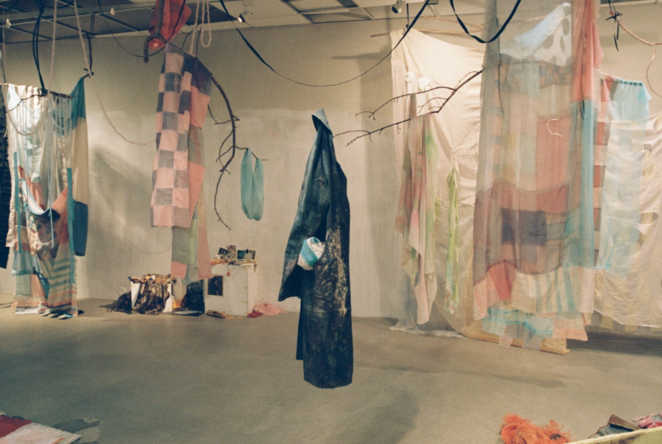
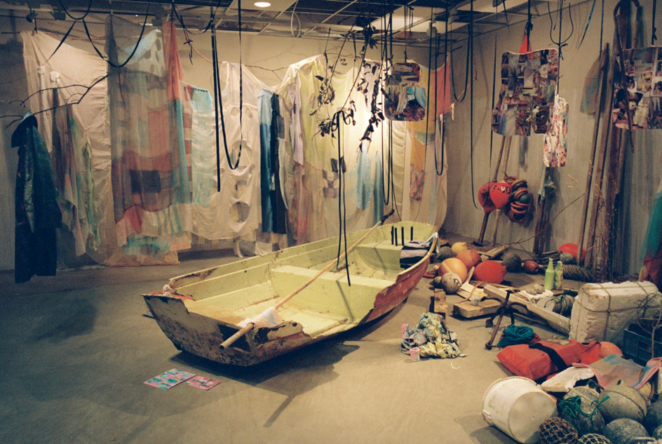
Installation images of Tricia Middletons work – – – – – – – – – – (2019) at NNKS. (Photo: Lena Trydal)
A Vegan Toothbrush?
The same beautiful façade of capitalism is in focus in Trygve Luktvasslimos’ film “Shallow Water Blackout”. During the opening weekend, the 40-minute-long film premiered at the tiny local cinema, but it is also constantly looping in its own film-room at the old Lofotpost-building.
Probably it is the only clearly sarcastic work at the festival. The sarcasm is used as a tool to convey the paradoxes in our ways to deal with the climate crisis. As an example of this is the vegan toothbrush, “The Humble Brush”, a toothbrush with a wooden shaft that presents itself as the natural option to the “problem” of the plastic toothbrush. In reality, it has a plastic brush, and it is no better than any other toothbrush.
Four grown-ups and a captain sit around a table, on a ship that really is a church, presenting their own stupid jobs as makers of some kind of product to save the world. It is truly a systematic critique, as capitalism is the system we depend on, yet, it is a system profoundly in opposition to what needs to be done in order to save the climate, namely, reduce our consumption. The rational voices of the film are two children, angry, roaring like wild animals. The young girl recounts a speech by Greta Thunberg, and the young boy ends the film by responding to, “I feel great”, with “I feel Greta”.
The film was created during a one-year residency that Luktvasslimo had, strangely enough, in his own home in the small village of Valberg. It is one out of four different residencies that have been completed in preparation for the festival, and in my opinion, they are the foundation of the entire biennale. LIAFs ability to include all the small villages around Lofoten is a strength. As in Valberg, where the entire community was involved in the film production. It makes the festival one for the local community, and not only the international art-elite. It is also only the local inhabitants who get the chance to see the entire festival, with new performances every weekend over the five weeks that it lasts.
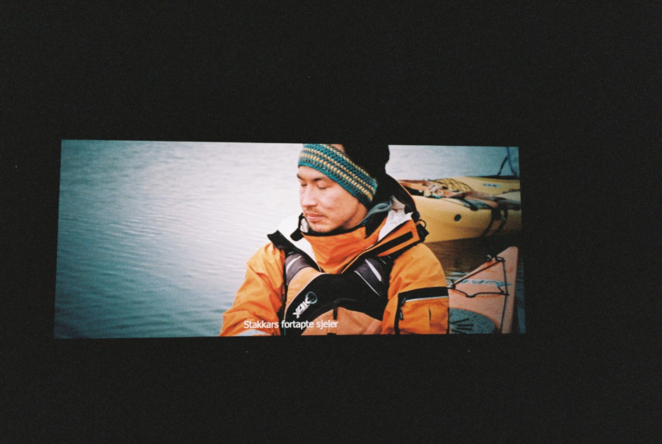
Still from the film «Shallow Water Blackout» (2019) by Trygve Luktvasslimo. (Photo: Lena Trydal)
The semiotics of the Cod
One of the performances only available during the opening weekend was also based on a residency. On the rich-mans island of Skrova, 40-minutes away from Svolvær by boat, the Portuguese duo João Pedro Vale and Nuno Alexandre Ferreira prepared the performance “Semiotics of the cod”.
In my opinion, the absurd and charmingly messy performance was the highlight of this year´s LIAF.
The two Portuguese invited the public to participate in the making of the traditional Portuguese dish, Bacalhau à Braz, in a partly yellow-painted corner of the former Lofotpost building.
It is not so easy to cook and tell stories at the same time. The water boiled over, and the manual video-presentation had to be constantly coordinated. While one stirred the pot, the other read stories about the cod, each story represented by a banner hanging around the seated public. Among several other things, the public learned about the varinas, a name for Portuguese women who carried fish in baskets on their heads and were known for an unorthodox dressing style and shoeless presence in the streets. We learned about the young Portuguese man’s relationship with the ocean throughout the history, and the codpiece, an old fashion for men to cover their genitals.
But in particular, the performance questioned the national. Bacalao, the Portuguese national dish, is made out of cod, from Lofoten. Is the dish actually Norwegian then? How is a dish national if the main ingredient comes from another country? And why are nations so willing to take in foreign food but not foreign people? As an ironic gesture, the two men had bought Lofoten-cod in Portugal and brought it back to Lofoten. And now, it had become the center-piece for a two-hour long performance. Over all, a performance with many layers and aesthetic impulses for its audience.
It all ended in a shared, delicious meal with a glass of wine. From art critic to food critic.
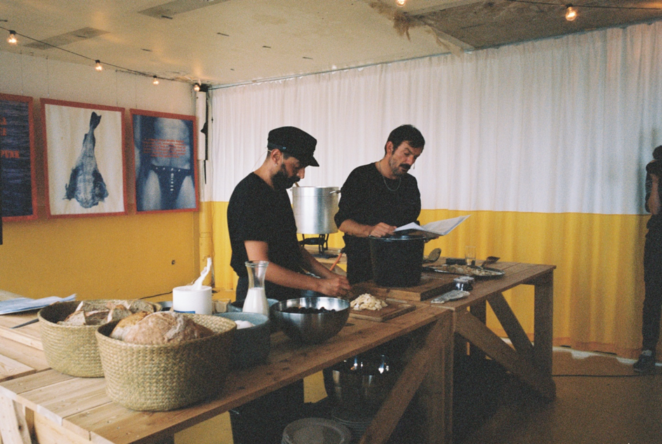
João Pedro Vale and Nuno Alexandre Ferreira preparing the Portuguese dish Bacalhau à Braz during the opening-weekend of LIAF. (Photo: Lena Trydal)
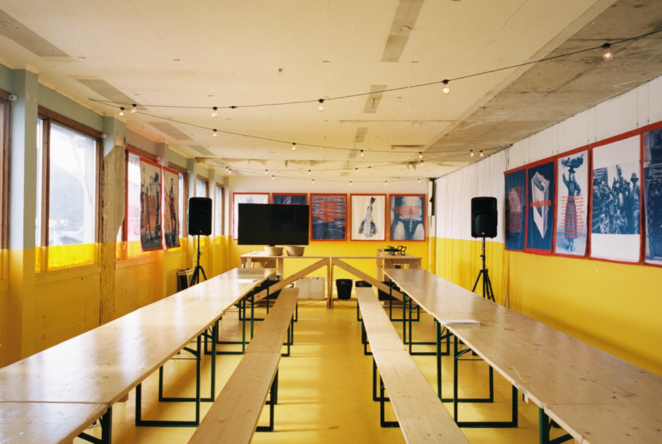
The audience can have a seat at the tables and hear stories about the cod, told by the two chefs behind their TV-show-like kitchen.
Lofoten International Art Festival (LIAF)
Svolvær, Norway
30/8 – 29/9/2019


